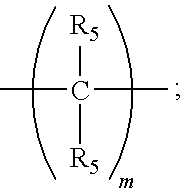Dendrimer Compositions
a technology of dendrimer and composition, which is applied in the field of dendrimer composition, can solve the problems of less than optimal phosphate binding properties, severe abnormalities in calcium and phosphorus metabolism, and many unwanted side effects
- Summary
- Abstract
- Description
- Claims
- Application Information
AI Technical Summary
Benefits of technology
Problems solved by technology
Method used
Image
Examples
example 1
Synthesis of Compound I
[0234]A 101 g sample of pentaerythritol was charged to a 2 L 3-necked round bottom flask under N2, and was slurried in 500 mL of acrylonitrile and 500 mL of 1,4-dioxane. A 9 mL portion of 40% KOH solution, and 18 mL of water were added to the reaction mixture, and the mixture stirred at room temperature. The reaction was heated to 40° C., at which point the pentaerythritol began dissolving. A slow exotherm began, and the reaction was cooled with ice to keep the temperature under 60° C. The reaction was stirred at room temperature overnight, and was analyzed by HPLC the following morning. The reaction mixture was transferred to a large separatory funnel, and was diluted with 2 L of tert-butyl methyl ether. The organic phase was then washed twice with 50% brine, was dried over anhydrous sodium sulfate, was filtered, and was concentrated in vacuo to yield 250 g of a light yellow oil, that solidified upon standing. The material was suitably pure to use for subsequ...
example 2a
Synthesis of Compound II
[0238]A 6 g sample of Compound I was placed in a Parr hydrogenation apparatus, and was suspended in 150 mL of 1:1 MeOH:H2O. 12 g of wet Raney cobalt catalyst were charged to this mixture, and the reaction vessel sealed. The resulting mixture was hydrogenated under 700 psi H2 at 70° C. for 18 h. The reaction vessel was cooled to room temperature, the resulting material was analyzed by LC / MS and filtered through a bed of celite. The filtrate was concentrated in vacuo to yield 5.8 g of the desired product as a pale yellow oil.
[0239]1H NMR (300 MHz, D2O): δ (ppm) 1.7 (m, 8H); 2.5 (t, 8H); 3.2 (s, 8H); 3.4 (t, 8H).
[0240]HPLC purity (ELSD): >98% AUC.
[0241]LC / MS [M+H]+ m / z=365.5 (exact mass of compound=364.300).
example 2b
Synthesis of Compound II
[0242]A 50 g sample of Compound I was placed in a Parr hydrogenation apparatus. To this, 5 g of freshly dried Raney cobalt was added in 30 mL of toluene, under N2. The hydrogenation apparatus was sealed, and evacuated. 20 psi of anhydrous ammonia was introduced, followed by 1200 psi of hydrogen. The reaction mixture was then heated to 109° C., and was stirred for 12 hr at which point the resulting material was cooled to room temperature and analyzed by LC / MS before being filtered over a small amount of celite (under N2), with the celite being washed several times with DCM. The filtrate was concentrated in vacuo to give 52 g of the desired product as a yellow oil.
[0243]1H NMR (300 MHz, D2O): δ (ppm) 1.7 (m, 8H); 2.5 (t, 8H); 3.2 (s, 8H); 3.4 (t, 8H).
[0244]HPLC purity (ELSD): >98% AUC.
[0245]LC / MS [M+H]+ m / z=365.5 (exact mass of compound=364.300).
PUM
| Property | Measurement | Unit |
|---|---|---|
| height | aaaaa | aaaaa |
| height | aaaaa | aaaaa |
| mean diameter | aaaaa | aaaaa |
Abstract
Description
Claims
Application Information
 Login to View More
Login to View More - R&D
- Intellectual Property
- Life Sciences
- Materials
- Tech Scout
- Unparalleled Data Quality
- Higher Quality Content
- 60% Fewer Hallucinations
Browse by: Latest US Patents, China's latest patents, Technical Efficacy Thesaurus, Application Domain, Technology Topic, Popular Technical Reports.
© 2025 PatSnap. All rights reserved.Legal|Privacy policy|Modern Slavery Act Transparency Statement|Sitemap|About US| Contact US: help@patsnap.com



